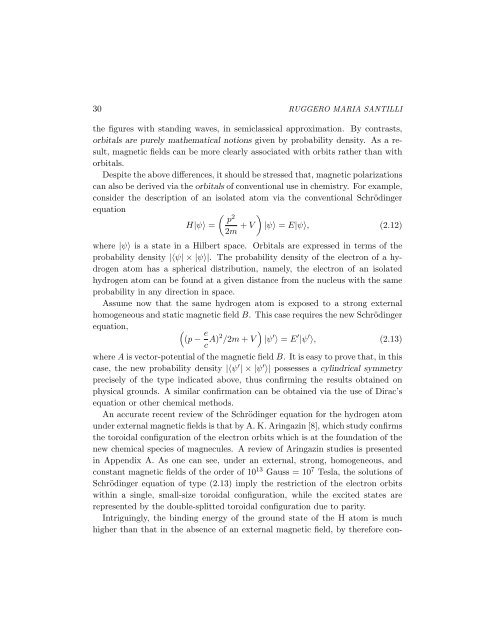the new fuels with magnecular structure - Institute for Basic Research
the new fuels with magnecular structure - Institute for Basic Research
the new fuels with magnecular structure - Institute for Basic Research
Create successful ePaper yourself
Turn your PDF publications into a flip-book with our unique Google optimized e-Paper software.
30 RUGGERO MARIA SANTILLI<br />
<strong>the</strong> figures <strong>with</strong> standing waves, in semiclassical approximation. By contrasts,<br />
orbitals are purely ma<strong>the</strong>matical notions given by probability density. As a result,<br />
magnetic fields can be more clearly associated <strong>with</strong> orbits ra<strong>the</strong>r than <strong>with</strong><br />
orbitals.<br />
Despite <strong>the</strong> above differences, it should be stressed that, magnetic polarizations<br />
can also be derived via <strong>the</strong> orbitals of conventional use in chemistry. For example,<br />
consider <strong>the</strong> description of an isolated atom via <strong>the</strong> conventional Schrödinger<br />
equation<br />
( ) p<br />
2<br />
H|ψ〉 =<br />
2m + V |ψ〉 = E|ψ〉, (2.12)<br />
where |ψ〉 is a state in a Hilbert space. Orbitals are expressed in terms of <strong>the</strong><br />
probability density |〈ψ| × |ψ〉|. The probability density of <strong>the</strong> electron of a hydrogen<br />
atom has a spherical distribution, namely, <strong>the</strong> electron of an isolated<br />
hydrogen atom can be found at a given distance from <strong>the</strong> nucleus <strong>with</strong> <strong>the</strong> same<br />
probability in any direction in space.<br />
Assume now that <strong>the</strong> same hydrogen atom is exposed to a strong external<br />
homogeneous and static magnetic field B. This case requires <strong>the</strong> <strong>new</strong> Schrödinger<br />
equation, (<br />
(p − e )<br />
c A)2 /2m + V |ψ ′ 〉 = E ′ |ψ ′ 〉, (2.13)<br />
where A is vector-potential of <strong>the</strong> magnetic field B. It is easy to prove that, in this<br />
case, <strong>the</strong> <strong>new</strong> probability density |〈ψ ′ | × |ψ ′ 〉| possesses a cylindrical symmetry<br />
precisely of <strong>the</strong> type indicated above, thus confirming <strong>the</strong> results obtained on<br />
physical grounds. A similar confirmation can be obtained via <strong>the</strong> use of Dirac’s<br />
equation or o<strong>the</strong>r chemical methods.<br />
An accurate recent review of <strong>the</strong> Schrödinger equation <strong>for</strong> <strong>the</strong> hydrogen atom<br />
under external magnetic fields is that by A. K. Aringazin [8], which study confirms<br />
<strong>the</strong> toroidal configuration of <strong>the</strong> electron orbits which is at <strong>the</strong> foundation of <strong>the</strong><br />
<strong>new</strong> chemical species of magnecules. A review of Aringazin studies is presented<br />
in Appendix A. As one can see, under an external, strong, homogeneous, and<br />
constant magnetic fields of <strong>the</strong> order of 10 13 Gauss = 10 7 Tesla, <strong>the</strong> solutions of<br />
Schrödinger equation of type (2.13) imply <strong>the</strong> restriction of <strong>the</strong> electron orbits<br />
<strong>with</strong>in a single, small-size toroidal configuration, while <strong>the</strong> excited states are<br />
represented by <strong>the</strong> double-splitted toroidal configuration due to parity.<br />
Intriguingly, <strong>the</strong> binding energy of <strong>the</strong> ground state of <strong>the</strong> H atom is much<br />
higher than that in <strong>the</strong> absence of an external magnetic field, by <strong>the</strong>re<strong>for</strong>e con-














